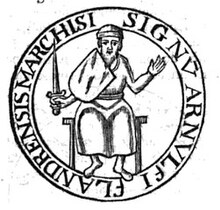Arnulf I, Count of Flanders
Arnulf I | |
|---|---|
 Seal of Arnulf I | |
| Count of Flanders | |
| Reign | 918 – 27 March 964 |
| Successor | Baldwin III Arnulf II |
| Born | between 893 and 899 |
| Died | 27 March 964 (aged 70–71) |
| Noble family | House of Flanders |
| Spouse(s) | Adele of Vermandois |
| Issue | Baldwin III, Count of Flanders |
| Father | Baldwin II of Flanders |
| Mother | Ælfthryth of Wessex |
Arnulf I (c. 893/899 – 27 March 964),[1] called "the Great",[2] was the first Count of Flanders.
Life[edit]
Arnulf was the son of margrave Baldwin II of Flanders and Ælfthryth of Wessex, daughter of Alfred the Great.[3] Through his mother he was a descendant of the Anglo-Saxon kings of England, and through his father, a descendant of Charlemagne.[4] Presumably Arnulf was named either after Saint Arnulf of Metz, a progenitor of the Carolingian dynasty,[5] or King Arnulf of Carinthia, whom his father supported.
At the death of their father in 918, Arnulf became Count of Flanders while his brother Adeloft or Adelolf succeeded to the County of Boulogne.[6] However, in 933 Adeloft died, and Arnulf took the countship of Boulogne for himself, but later conveyed it to his nephew, Arnulf II.[7] Arnulf titled himself count by the Grace of God.[8]
Arnulf I greatly expanded Flemish rule to the south, taking all or part of Artois, Ponthieu, Amiens, and Ostrevent. He exploited the conflicts between Charles the Simple and Robert I of France, and later those between Louis IV and his barons. Arnulf also made Bruges the center of his administration, contributing to the rise of the town as a major trading hub.[9]
In his southern expansion Arnulf inevitably had conflict with the Normans, who were trying to secure their northern frontier. This led to the 942 murder of the Duke of Normandy, William Longsword, at the hands of Arnulf's men.[10] The Viking threat was receding during the later years of Arnulf's life, and he turned his attentions to the reform of the Flemish government. Count Arnulf died on 27 March 964, allegedly murdered by Heluin in revenge for the murder of William Longsword.
He was buried in the Saint-Peter's Abbey in Ghent.[11]
Family[edit]
The name of Arnulf's first wife is unknown but he had at least one daughter by her:[12]
- Name unknown; married Isaac of Cambrai. Their son Arnulf succeeded his father as Count of Cambrai.[12]
In 934 he married Adele of Vermandois, daughter of Herbert II of Vermandois.[13] Their children were:
- Hildegard, born c. 934, died 990; she married Dirk II, Count of Holland. It is uncertain whether she is his daughter by his first or second wife.[12]
- Liutgard, born in 935, died in 962; married Wichmann IV, Count of Hamaland.[13]
- Egbert, died 953.
- Baldwin III of Flanders (c. 940 – 962),[14] married Matilda of Saxony († 1008), daughter of Hermann Billung.
- Elftrude; married Siegfried, Count of Guînes.
Succession[edit]
Arnulf made his eldest son and heir Baldwin III of Flanders co-ruler in 958, but Baldwin died untimely in 962,[14] so Arnulf was succeeded by Baldwin's infant son, Arnulf II of Flanders.[15]
See also[edit]
References[edit]
- ^ H. E. L. Mellersh; Neville Williams (1999). Chronology of World History. ABC-CLIO. ISBN 978-1-57607-155-7.
- ^ "Arnulf I, Count of Flanders". British Museum.
- ^ Webster 2021, p. 43.
- ^ The Annals of Flodoard of Reims, 919–966, ed. Steven Fanning & Bernard S. Bachrach (University of Toronto Press, CA, 2011), p. xx
- ^ Philip Grierson, 'The Relations between England and Flanders before the Norman Conquest', Transactions of the Royal Historical Society, Vol. 23 (1941), p. 86 n. 1
- ^ Murray 2000, p. 27.
- ^ Renée Nip, 'The Political Relations between England and Flanders (1066–1128)', Anglo-Norman Studies 21: Proceedings of the Battle Conference 1998, ed. Christopher Harper-Bill (The Boydell Press, Woodbridge, UK, 1999), p. 150
- ^ Jan, Régine Le; LeJan, Régine (1995). Famille et pouvoir dans le monde franc (VIIe-Xe siècle): essai d'anthropologie sociale (in French). Publications de la Sorbonne. ISBN 978-2-85944-268-2.
- ^ Arnade, Peter (2019). "Medieval Bruges, c. 850–1550. Andrew Brown and Jan Dumolyn, eds. Cambridge: Cambridge University Press, 2018. xxii + 550 pp. $99.99". Renaissance Quarterly. 72 (3): 1071–1073. doi:10.1017/rqx.2019.306. ISSN 0034-4338. S2CID 204472055.
- ^ David Nicholas, Medieval Flanders (Longman Group UK Limited, London, 1992), p. 40
- ^ "Arnulf (Arnoul) I "the Great" or "the Old" (Arnulfus Magnus, Arnulfus Vetulus) Marquis of Flanders, 918-964×5". The Henry Project. Retrieved 5 December 2018.
- ^ a b c Heather J. Tanner, Families, Friends and Allies: Boulogne and Politics in Northern France and England, C.879–1160 (Brill, Leiden, Netherlands, 2004) p. 55 n. 143
- ^ a b Tanner 2004, p. 55.
- ^ a b Arblaster 2019, p. 244.
- ^ Nicholas 1992, p. 43.
Sources[edit]
- Arblaster, Paul (2019). A History of the Low Countries. Macmillan Education UK.
- Murray, Alan V. (2000). The Crusader Kingdom of Jerusalem: A Dynastic History 1099-1125. Prosopographica et Genealogica.
- Nicholas, David M (1992). Medieval Flanders. Routledge.
- Tanner, Heather (2004). Families, Friends and Allies. Brill.55
- Webster, Paul, ed. (2021). History of the Dukes of Normandy and the Kings of England by the Anonymous. Routledge.
Additional references[edit]
- Folcwine
- Lambert of Ardres
- Platts, Beryl. The Scottish Hazard: Flemish Nobility and their Impact on Scotland, 1985
